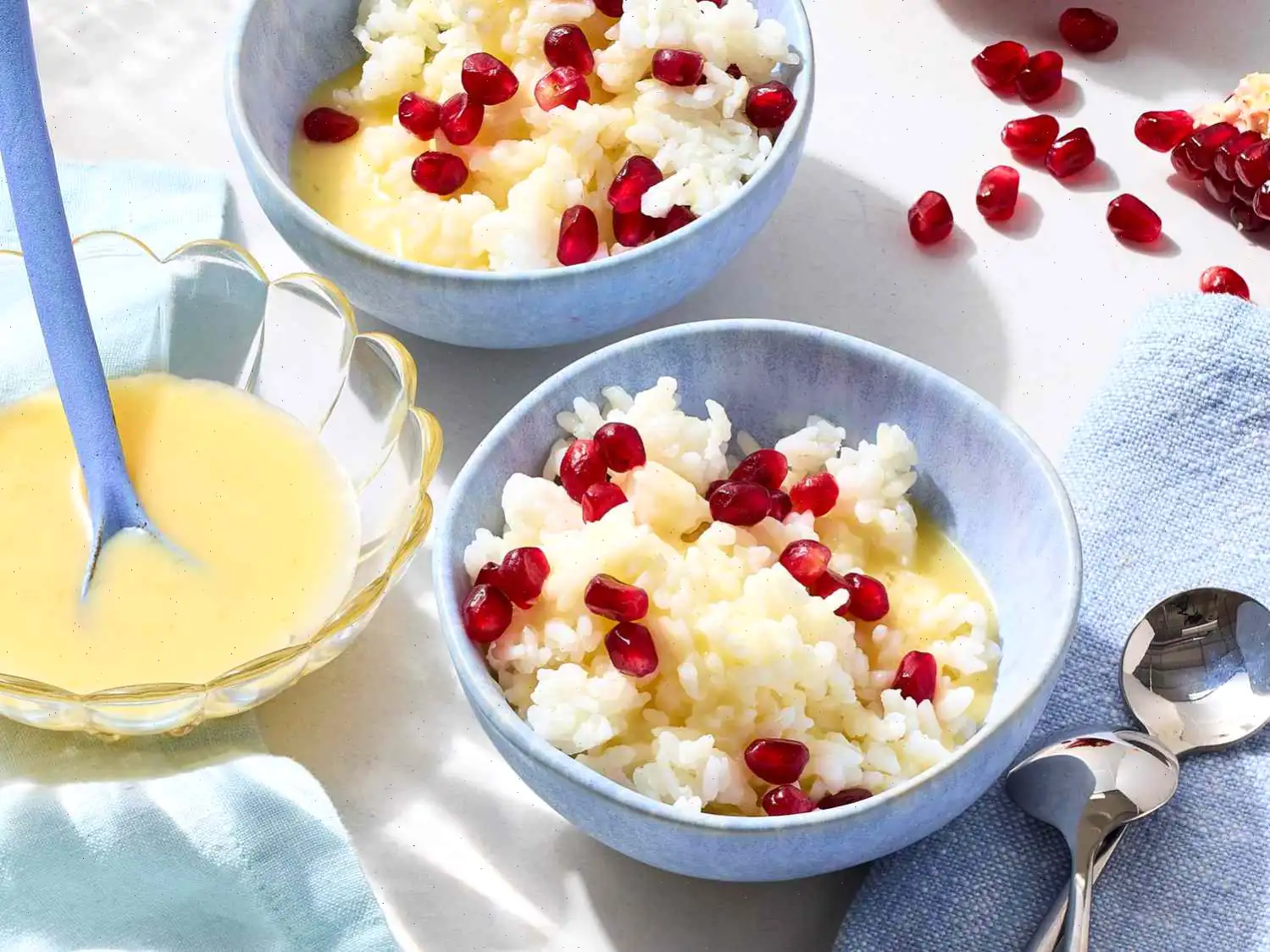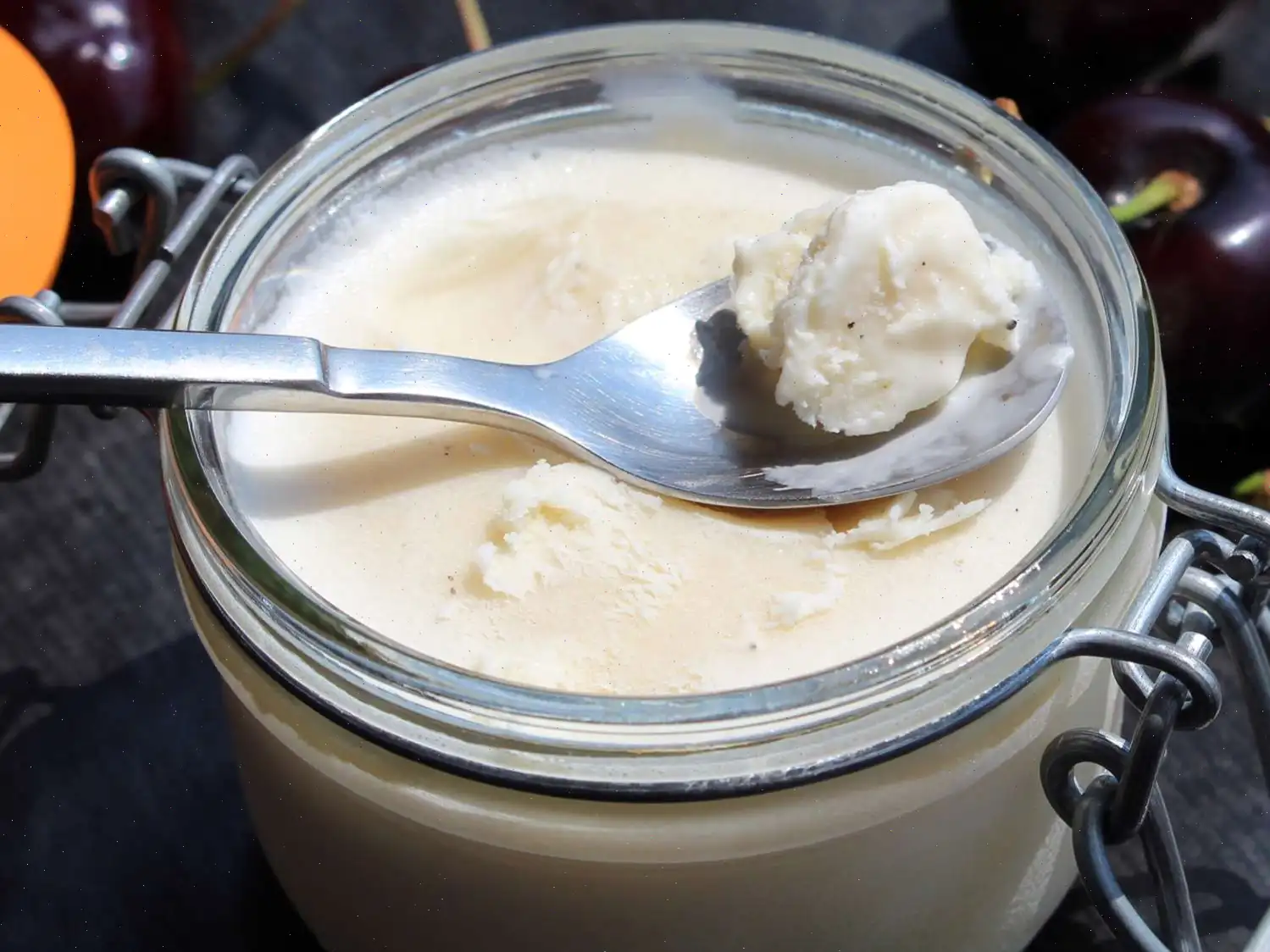
Sticky Rice with Passion Fruit Sauce Recipe
Ingredients
- 1 1/2 cups water
- 1 1/4 cups uncooked glutinous sticky white rice, rinsed well
- 1 (13.5 to 14 ounce) can unsweetened coconut milk
- 1/2 cup white sugar
- 1/2 teaspoon salt
- 1 teaspoon tapioca starch
- 2 tablespoons passion fruit puree
- 1/4 cup pomegranate arils
Directions
- In a medium saucepan, stir together the water and rice. Bring the mixture to a boil over high heat. Once boiling, reduce the heat to low, cover the pan, and simmer until the water is absorbed, about 15 to 20 minutes. Let the rice stand for 10 minutes.
- While the rice is resting, combine the coconut milk, sugar, and salt in a small saucepan. Bring the mixture to a boil over high heat, stirring frequently. Once it reaches a boil, remove it from the heat.
- Reserve 1/3 cup of the coconut milk mixture for the sauce, then pour the remaining mixture over the cooked rice. Stir gently to combine, then cover and let it cool for 1 hour.
- For the sauce, whisk the reserved coconut milk mixture with the tapioca starch in the same small saucepan. Bring it to a boil over high heat, stirring frequently. Continue stirring and cook for about 2 minutes, or until the sauce thickens. Remove from heat and stir in the passion fruit puree.
- Before serving, stir the rice to redistribute the coconut milk. Spoon the rice into serving dishes, drizzle with the sauce, and sprinkle with pomegranate arils for a burst of color and flavor.
- If there are any leftovers, both the rice and the sauce can be stored in separate airtight s in the refrigerator for up to 5 days.
Nutrition Facts (per serving)
- Calories: 270
- Total Fat: 15g (19% Daily Value)
- Saturated Fat: 12g (61% Daily Value)
- Cholesterol: 0mg (0% Daily Value)
- Sodium: 170mg (7% Daily Value)
- Total Carbohydrate: 36g (13% Daily Value)
- Dietary Fiber: 3g (12% Daily Value)
- Total Sugars: 23g
- Protein: 3g (6% Daily Value)
- Vitamin C: 9mg (10% Daily Value)
- Calcium: 41mg (3% Daily Value)
- Iron: 3mg (15% Daily Value)
- Potassium: 329mg (7% Daily Value)
Percent Daily Values are based on a 2,000 calorie diet. Your daily values may be higher or lower depending on your calorie needs.
Sticky Rice with Passion Fruit Sauce: Cultural Background and Unique Traits
Origin History
Sticky rice desserts have deep roots in Southeast Asian culinary tradition, especially in Thailand, where glutinous rice has been a dietary staple for centuries. Historically, sticky rice was steamed in bamboo baskets over wood fires, creating a naturally fragrant base for both savory and sweet dishes. The pairing of rice with tropical fruits emerged as trade routes expanded and exotic produce became more accessible. Passion fruit, though not native to Thailand, quickly integrated into modern Thai cuisine for its vibrant acidity, offering a contemporary twist on a time-honored preparation.
Regional Characteristics
Across Thailand, sticky rice desserts vary subtly depending on local climate and available produce. In the north, where rice cultivation dominates, the grain is typically denser and more aromatic. Coastal regions, influenced by abundant coconut groves, traditionally feature richer coconut sauces. The addition of passion fruit reflects a growing preference for fresh, tangy flavors common in modern Thai fusion cooking, demonstrating how regional gastronomy evolves while still honoring its foundations.
Differences from Similar Dishes
While reminiscent of the classic mango sticky rice, this version differs through its brighter, sharper flavor profile. Mango brings mellow sweetness, whereas passion fruit introduces tart complexity and a naturally perfumed aroma. The inclusion of tapioca-thickened sauce also sets it apart from simpler syrup-based toppings. Compared with other Asian rice dessertssuch as Filipino suman or Laotian khao lamthis dish emphasizes creaminess over smokiness or spice, leaning on coconut and fruit rather than caramelized notes.
Where It Is Commonly Served
Sticky Rice with Passion Fruit Sauce is typically enjoyed in Thai cafs, street vendors' stalls, and casual restaurants during warm seasons when fruit-based desserts are most popular. It is also frequently featured at festive gatherings, where its bright colors and refreshing taste make it a favorite among guests. In international Thai eateries, it appears as a modern dessert option appealing to diners seeking something familiar yet elevated.
Interesting Facts
Passion fruits natural acidity enhances the richness of coconut milk, creating a balanced contrast prized by dessert chefs. Sticky rice is unique in that its texture relies on amylopectin, a starch that turns soft and chewy without becoming mushy. Another fun detail: in Thailand, sticky rice is traditionally eaten with the hands, even in desserts, emphasizing its cultural role not just as food but as a tactile experience. The combination with pomegranate arils, a more recent addition, introduces color and crunch, making the dish both visually striking and texturally layered.








